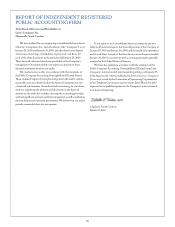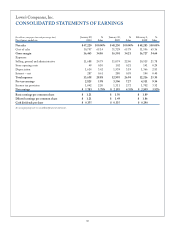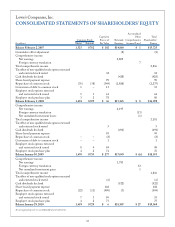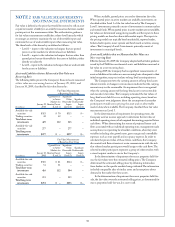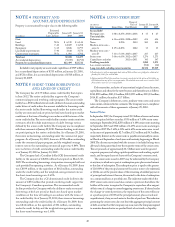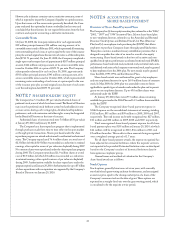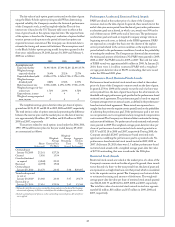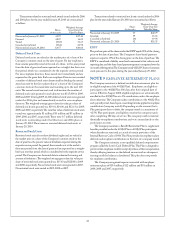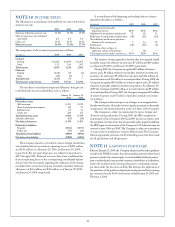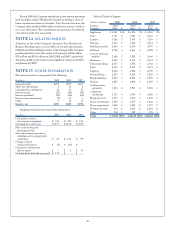Lowe's 2009 Annual Report Download - page 38
Download and view the complete annual report
Please find page 38 of the 2009 Lowe's annual report below. You can navigate through the pages in the report by either clicking on the pages listed below, or by using the keyword search tool below to find specific information within the annual report.
36
Leases – For lease agreements that provide for escalating rent
payments or free-rent occupancy periods, the Company recognizes
rent expense on a straight-line basis over the non-cancelable lease term
and option renewal periods where failure to exercise such options would
result in an economic penalty in such amount that renewal appears,
at the inception of the lease, to be reasonably assured. e lease term
commences on the date that the Company takes possession of or
controls the physical use of the property. Deferred rent is included in
other liabilities (non-current) on the consolidated balance sheets.
Accounts Payable – e Company has an agreement with a third
party to provide an accounts payable tracking system which facilitates
participating suppliers’ ability to finance payment obligations from the
Company with designated third-party financial institutions. Participating
suppliers may, at their sole discretion, make offers to finance one or
more payment obligations of the Company prior to their scheduled
due dates at a discounted price to participating financial institutions.
e Company’s goal in entering into this arrangement is to capture
overall supply chain savings, in the form of pricing, payment terms
or vendor funding, created by facilitating suppliers’ ability to finance
payment obligations at more favorable discount rates, while providing
them with greater working capital flexibility.
e Company’s obligations to its suppliers, including amounts
due and scheduled payment dates, are not impacted by suppliers’
decisions to finance amounts under this arrangement. However, the
Company’s right to offset balances due from suppliers against payment
obligations is restricted by this arrangement for those payment obligations
that have been financed by suppliers. As of January 29, 2010 and
January 30, 2009, $602 million and $393 million, respectively, of the
Company’s outstanding payment obligations had been placed on the
accounts payable tracking system, and participating suppliers had
financed $253 million and $370 million, respectively, of those payment
obligations to participating financial institutions.
Self-Insurance – e Company is self-insured for certain losses
relating to workers’ compensation, automobile, property, and general
and product liability claims. e Company has stop-loss coverage to
limit the exposure arising from these claims. e Company is also
self-insured for certain losses relating to extended warranty and medical
and dental claims. Self-insurance claims filed and claims incurred but
not reported are accrued based upon management’s estimates of the
discounted ultimate cost for self-insured claims incurred using actuarial
assumptions followed in the insurance industry and historical experience.
Although management believes it has the ability to reasonably estimate
losses related to claims, it is possible that actual results could differ from
recorded self-insurance liabilities.
Income Taxes – e Company establishes deferred income tax assets
and liabilities for temporary differences between the tax and financial
accounting bases of assets and liabilities. e tax effects of such differences
are reflected in the balance sheet at the enacted tax rates expected to be
in effect when the differences reverse. A valuation allowance is recorded
to reduce the carrying amount of deferred tax assets if it is more likely
than not that all or a portion of the asset will not be realized. e tax
balances and income tax expense recognized by the Company are based on
management’s interpretation of the tax statutes of multiple jurisdictions.
e Company establishes a liability for tax positions for which there
is uncertainty as to whether or not the position will be ultimately sustained.
e Company includes interest related to tax issues as part of net interest
on the consolidated financial statements. e Company records any
applicable penalties related to tax issues within the income tax provision.
Revenue Recognition – e Company recognizes revenues, net of
sales tax, when sales transactions occur and customers take possession
of the merchandise. A provision for anticipated merchandise returns is
provided through a reduction of sales and cost of sales in the period
that the related sales are recorded. Revenues from product installation
services are recognized when the installation is completed. Deferred
revenues associated with amounts received for which customers have
not yet taken possession of merchandise or for which installation has not
yet been completed were $354 million and $328 million at January 29,
2010, and January 30, 2009, respectively.
Revenues from stored-value cards, which include gift cards and
returned merchandise credits, are deferred and recognized when the
cards are redeemed. e liability associated with outstanding stored-
value cards was $329 million and $346 million at January 29, 2010,
and January 30, 2009, respectively, and these amounts are included in
deferred revenue on the consolidated balance sheets. e Company
recognizes income from unredeemed stored-value cards at the point at
which redemption becomes remote. e Company’s stored-value cards
have no expiration date or dormancy fees. erefore, to determine
when redemption is remote, the Company analyzes an aging of the
unredeemed cards based on the date of last stored-value card use.
Extended Warranties – e Company sells separately-priced
extended warranty contracts under a Lowe’s-branded program for which
the Company is ultimately self-insured. e Company recognizes
revenue from extended warranty sales on a straight-line basis over the
respective contract term. Extended warranty contract terms primarily
range from one to four years from the date of purchase or the end of
the manufacturer’s warranty, as applicable. e Company’s extended
warranty deferred revenue is included in other liabilities (non-current)
on the consolidated balance sheets. Changes in deferred revenue for
extended warranty contracts are summarized as follows:
(In millions) 2009 2008
Extended warranty deferred revenue,
beginning of year $ 479 $ 407
Additions to deferred revenue 220 193
Deferred revenue recognized (150) (121)
Extended warranty deferred revenue, end of year $ 549 $ 479
Incremental direct acquisition costs associated with the sale of
extended warranties are also deferred and recognized as expense on a
straight-line basis over the respective contract term. Deferred costs
associated with extended warranty contracts were $150 million and
$121 million at January 29, 2010 and January 30, 2009, respectively.
e Company’s extended warranty deferred costs are included in other
assets (non-current) on the consolidated balance sheets. All other costs,
such as costs of services performed under the contract, general and
administrative expenses and advertising expenses are expensed as incurred.
e liability for extended warranty claims incurred is included in
other current liabilities on the consolidated balance sheets. Changes in
the liability for extended warranty claims are summarized as follows:
(In millions) 2009 2008
Liability for extended warranty claims,
beginning of year $ 17 $ 14
Accrual for claims incurred 67 53
Claim payments (61) (50)
Liability for extended warranty claims, end of year $ 23 $ 17




